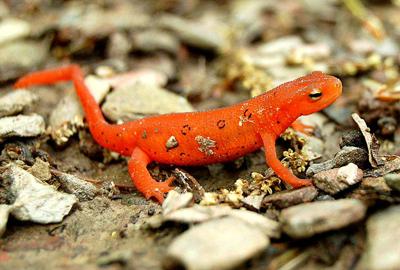Shelburne’s gravelly Pond Road probably doesn’t look intimidating to human drivers. But to an inch-and-a-half-long amphibian, Pond Road divides worlds. And early spring’s warm(ish) nights are an active, sometimes dangerous, time for Vermont’s amphibians to move from one world to another.
Amphibians, appearing in wetlands and on roadways on spring nights, play an important role in our environmental knowledge. “If you look at amphibians, as many people do, as indicators of environmental health…if we’re having problems locally with these species, it’s not because of something going on in Guatemala or Central America,” said UVM adjunct professor Jim Andrews. “It’s because of how we’re managing our land right here, so if we can’t maintain these species here, it’s our own fault.”
“If you look at environmental health broadly, that’s really what our lives, and our economy, and our tourist economy, all depend on,” Andrews noted. “Clean water, clean air, recreational lands, hunting and fishing and flood control, pollinators, you name it, it’s our life support system, and these guys are part of that life support system.”
Part of this system are amphibians’ migrations, which, while averaging only a few hundred feet, are perilous as they make their way from wintering-over grounds to spring spawning locations.
Andrews, a herpetologist – a scientist who studies reptiles and amphibians – noted that winter survival might mean finding a location, such as rodent tunnels and cracks in the ground or house foundations, where the water table is lower because amphibians need to get deep enough underground to remain below the frost line. Other amphibians simply burrow into the leaf litter to avoid desiccation, then freeze, their hearts and lungs stopping for the season. An antifreeze-like substance prevents their cells from freezing and bursting; the fluid between cells freezes.
When the weather warms – even rainy, 35-degree nights suffice – some amphibians head for spawning grounds, a tricky journey. While their winter grounds are typically at higher elevations, amphibians spawn in lower-elevation wetlands nearby. Though brief, the journey often involves crossing a road, such as Pond Road in Shelburne. These crossings can incur high mortality, especially since amphibians travel by night.
Fluctuating early spring temperatures present another challenge, said Andrews. Some amphibians, including spring peepers and some frogs, can freeze and thaw a time or two, but not indefinitely – their “antifreeze” eventually depletes. And salamanders can’t handle freeze-thaw cycles; they’re in trouble if the ground refreezes.
Amphibians also use vernal (temporary) pools, which, lacking fish, are safer from predators. It’s a tough balance, explained Andrews: amphibians must migrate late enough to avoid dangerous cold, but lay their eggs early enough for young to make it through the larval (aquatic) stage before these seasonal ponds dry up.
Andrews noted several unusually early amphibian movements in the last decade, naming global warming the likely culprit. An early spring that stayed mild wouldn’t be so dangerous, he noted. But fluctuating warm spells and cold snaps present challenges.
This March 1, said Andrews, amphibians were on the move in the Champlain Valley.
“We’ve never seen this movement this early,” said Andrews. “Ordinarily it would be late March.”
Other climate-related changes, like less winter snow, also create problems for amphibians overwintering underground. Without insulating winter snow, burrowed amphibians can freeze. And a summer drought can kill off all the young amphibians that haven’t yet made it out of a disappearing pond.
With amphibians (and reptiles) facing so many challenges, residents can help by keeping an eye out for these animals as they go about their days – and nights. Vermont Herpatlas, a website for tracking amphibians and reptiles, began in the 1990s with herpetologists asking the public to report their sightings. At that time, a volunteer group of scientists was acting as a scientific advisory group to the Vermont Endangered Species Committee, and realized they lacked sufficient data about these animals’ distributions, without which it was difficult to know how to preserve them.
“How do you know if something is disappearing from a town if it never has even been reported from that town?” said Andrews. It’s a simple way to get involved: if you spot a reptile or amphibian, photograph and report it. If you know of a place where amphibians are crossing roads, (safely!) take photos and do a rough count. Don’t forget dead ones; spots where many amphibians are getting killed might be candidates for a wildlife underpass.
“There are lots of sites that we don’t know about,” said Andrews. Send him reports and photos (jandrews@middlebury.edu), or use the submission form at vtherpatlas.org.
Andrews and colleagues will be keeping an eye out on warm, rainy spring nights. “I think we have an ethical responsibility to try to maintain the species diversity,” Andrews said, “the beautiful mosaic of life for future generations of humans and future generations of critters.”















(0) comments
Welcome to the discussion.
Log In
Keep it clean. Please avoid obscene, vulgar, lewd, racist or sexual language.
PLEASE TURN OFF YOUR CAPS LOCK.
Don't threaten. Threats of harming another person will not be tolerated.
Be truthful. Don't knowingly lie about anyone or anything.
Be nice. No racism, sexism or any sort of -ism that is degrading to another person.
Be proactive. Use the "Report" link on each comment to let us know of abusive posts.
Share with us. We'd love to hear eyewitness accounts, the history behind an article.